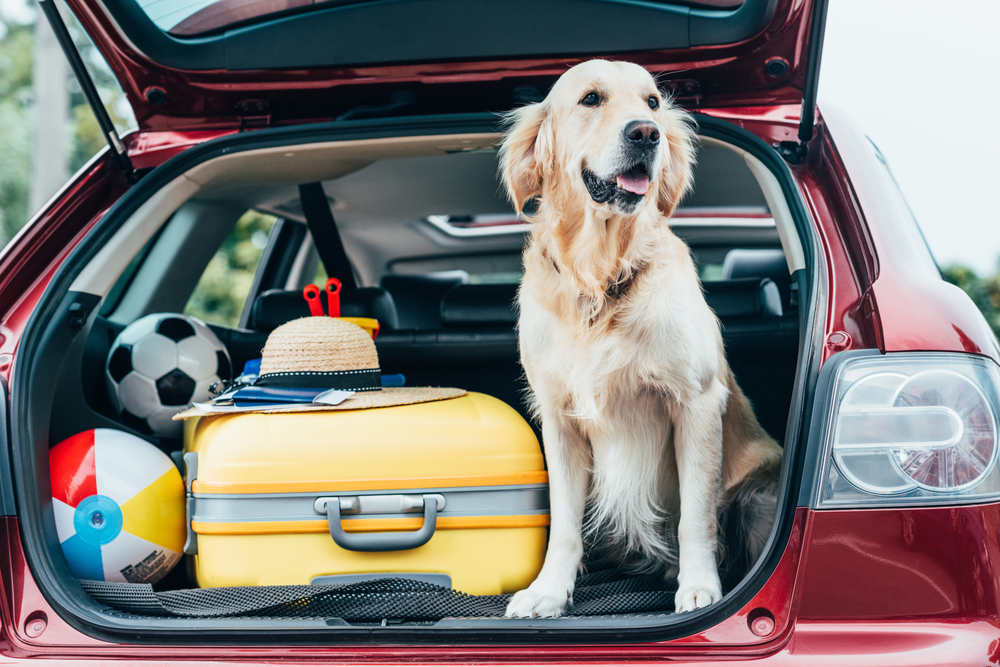Car Safety Tips For Traveling With Pets

The holidays are right around the corner, and for many Americans that means traveling across states to visit family and friends. Since the pandemic, air travel has significantly reduced with many choosing to travel on wheels instead. If you’re planning on bringing your furry friend to your holiday destination, be sure to use these car safety tips for traveling with pets.
1. Prepare in advance
Traveling can be stressful on you and your pet. Preparing in advance can help ensure your trip goes smoothly. If your pet is uncomfortable with car rides, try building their tolerance with short occasional drives. In extreme cases, veterinarians can prescribe anxiety medications to help calm your pet on the road. There are also calming treats that can be purchased over the counter if you can’t get in to see a veterinarian. Just make sure to try a small dose on your pet before your trip to test their sensitivity.
2. Put together a travel kit
Having a travel kit for your pet is essential for a hassle-free trip. Always make sure you bring your pet’s food, water, and bowls. It’s also a smart idea to bring more than you think you need — better to be safe than sorry!
In your pet’s travel kit should also be their leash, harness/collar, and waste bags for when you take them on potty breaks. If your pet requires medication, be sure to pack that too. Lastly, it’s always a good idea to have a first aid kit for your pet (and humans too!) in the case of an emergency. In it, keep copies of your pet’s medical records in case you need them while traveling interstate or have to take them to an emergency vet.
3. Properly strap them in
The single most important car safety tip for traveling with pets is to buckle them up. Just like us, our pets need to be wearing proper restraints at all times in a moving vehicle. If a collision were to happen and your pet was not properly harnessed, it could result in serious injury.
The best thing to do is buy a pet seatbelt, which can be found in most pet supply stores and online. These can be buckled into your vehicle’s seatbelt while the other end attaches to your pet’s harness. Always make sure it is securely fastened before driving.
For small breeds, carriers can work too — similarly, just make sure to fasten the carrier using the car’s seatbelt!
4. Make frequent stops for food, water, and potty breaks
Frequent stops can help ease the stress on your pet from traveling. Not only does it give them a chance to stretch their legs, but it also helps them burn off any excess energy and reduce anxiety.
When you are resting at a stop, make sure your pet is always wearing identification tags. Additionally, never let your pet out of the vehicle without a leash. Pets in unfamiliar environments are known to run off, so it’s better not to put them at risk and keep them leashed.
While water is normally okay to drink in the car, be sure to feed your pet before your trip to reduce motion sickness. If they need to eat, give them time to properly digest before hitting the road again.
5. Keep them entertained with toys
Chew toys are a great way to keep anxiety at bay for nervous pets. When packing for your trip, be sure to include some toys and entertainment for your furry friends. Boredom can cause restlessness, and your pet may be tempted to chew up your car’s interior.
Additionally, while it may be tempting to let your pet stick their head out of the window to keep them happy, doing so can be dangerous. The wind and cold air can cause inner-ear damage and lung infections, and some dogs may even try to jump out.
6. Never leave your pet unattended in a parked vehicle.
Regardless of temperature, it is never safe to leave your pet unattended in a vehicle. In fact, it is illegal in most states to do so. Instead of leaving your pet alone, ask to see if you can bring them into the business or place you’re visiting. You’d be surprised how many businesses are happy to allow pets as long as they are on a leash or inside a carrier!


